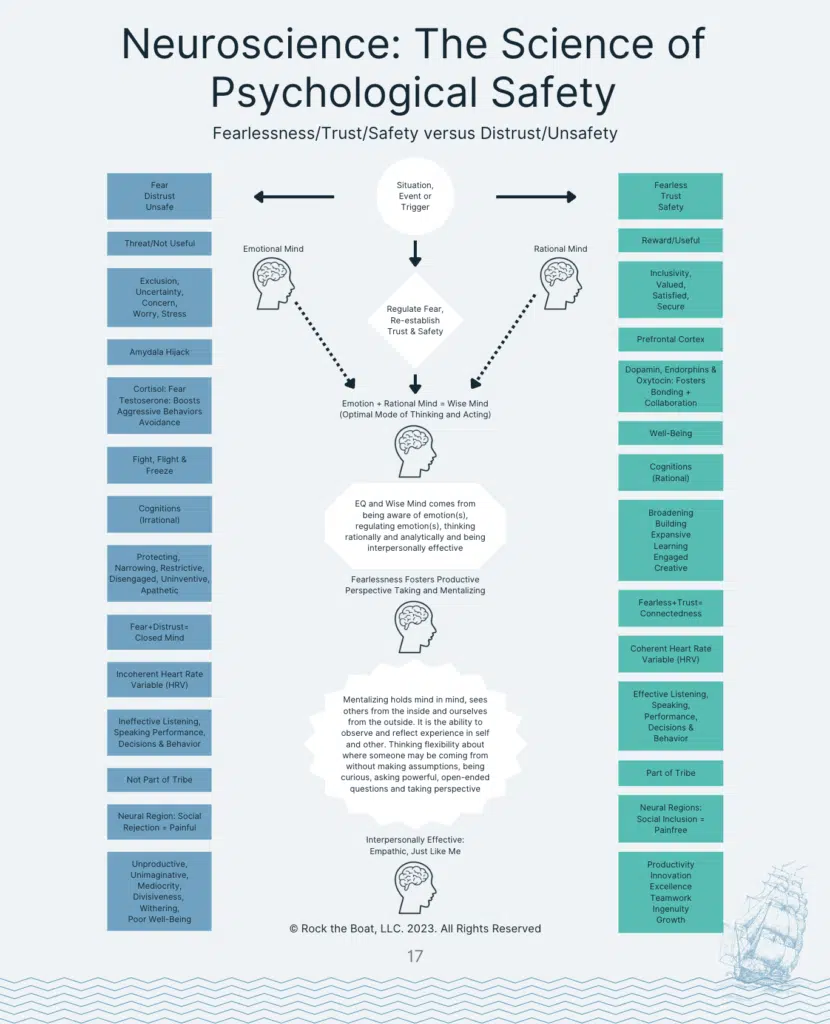The Science of Fearless versus Fearful Organizations: Visual Framework
The following visual framework helps us see the salient elements, components, and influencers to build a fearless culture based on psychological safety. It takes us from insecurity, uncertainty, anxiety, apathy, and apprehension. Next, it moves us towards a speak-up culture of taking interpersonal risks, course correcting, preventing mistakes and errors, or warding off catastrophic errors. Once psychological safety is built, it thrives on the team level, allowing people to work more productively and synergistically.
What is the Science of Fearless versus Fearful Organizations?
Visual Framework

What is the Link Between Safety and Trust Versus Fearful and Threatened?
When we experience safety and trust, our brains release dopamine, the feel-good hormone responsible for pleasure, satisfaction, and motivation. This impacts well-being in and outside of the workplace.
Feeling safe elicits our parasympathetic nervous system, a network of nerves that relaxes our bodies. This evokes being calm, peaceful, open, courteous, and curious. It prompts us to connect and socialize, giving us a sense of belonging. Safety allows our bodies to relax, slowing breathing and heart rates. We become more approachable, friendly, and receptive. We are more present and receptive to listening and learning new information. Our facial expressions are relaxed, and we make good eye contact signaling connectedness and a warm smile.
Why is this Important?
From an evolutionary vantage point, the prefrontal cortex (PFC) is the newest part of our brain responsible for decision-making and cognitive control. It helps us think analytically, make decisions, regulate social behaviors, and express ourselves. This is often called the ‘reasonable’ or ‘rational’ mind in psychiatry. The PFC is necessary for self-regulation, perspective-taking, empathy, and acknowledging others. Also, it drives logic, creativity, and analytical thinking. Our prefrontal cortex (PFC) fosters productivity and effectiveness in and outside the workplace. Research has discovered that when individuals experience trust and safety, the PFC is more active, allowing for increased cognitive control and effective decision-making.
What are the Negative Effects of Fear?
When we become fearful or threatened, the prefrontal cortex (PFC) elicits our sympathetic nervous system, which produces ways to respond to dangerous or stressful situations. The sympathetic nervous system orients us to take a defensive stance and moves us towards a fight, flight, or flee response(s). When we feel fearful or threatened, neurochemically, our brains release cortisol, the stress hormone that negatively impacts learning and memory. This mind state is an ’emotion mind’; we become anxious, irritated, and reactive, our bodies tense, our heart rates speed up, and we sweat. We are less receptive to listening and learning in this heightened state of duress. Evolutionary, our minds have evolved to think negatively, dating back to the stone age days of cavemen and cavewomen. The stone age mindset was geared towards safety and survival by avoiding threats and danger, being part of a tribe (if you’re alone, you’ll die), giving us a sense of belonging, safety in numbers, and working collaboratively to notice, anticipate, and avoid threats.
All bets are off with Amygdala Hijack!
The amygdala is responsible for processing emotional information. It is an instinctive part of our brain that is an essential feature, ensuring our survival as a species from an evolutionary vantage point. Our brains are biologically hard-wired to perceive and respond to psychological threats similarly to physical threats, but psychological threats tend to linger longer. We scan, monitor, detect, and manage any physical or perceived psychological threat and react in a fight-flight or freeze manner.
In a threatening situation, we have a heightened sense of emotionality, vigilance, and alertness. As a result, we may become highly sensitive and reactive interpersonally. When we feel socially ostracized interpersonally, it can elicit the same sensation of pain receptors that are experienced from physical pain caused by injuries. When our amygdala is hijacked, we may lose self-control, whereby decreases our capacities to think rationally and objectively, impairs thinking and memory, decreases perspective taking, and decreases creativity, concentration, decision-making, and interpersonal effectiveness. Interestingly, we benefit from moderate stress levels to fuel and mobilize action and motivation versus tipping the balance.
When people feel disrespected, mistreated, silenced, undervalued, unappreciated, or overwhelmed in the workplace, the amygdala may trigger a hijack, causing a person to respond impulsively and emotionally rather than logically and calmly. When we experience trust and safety within a group, the amygdala is less active, diminishing fear responses of fight, flight, and freeze.
Recommended Reading:
Meet Jodie, your Culture & Transformation Captain. With over twenty years helping people change, facilitating team discussions, building cultures, designing, implementing and teaching classes, your organization is in good hands.


